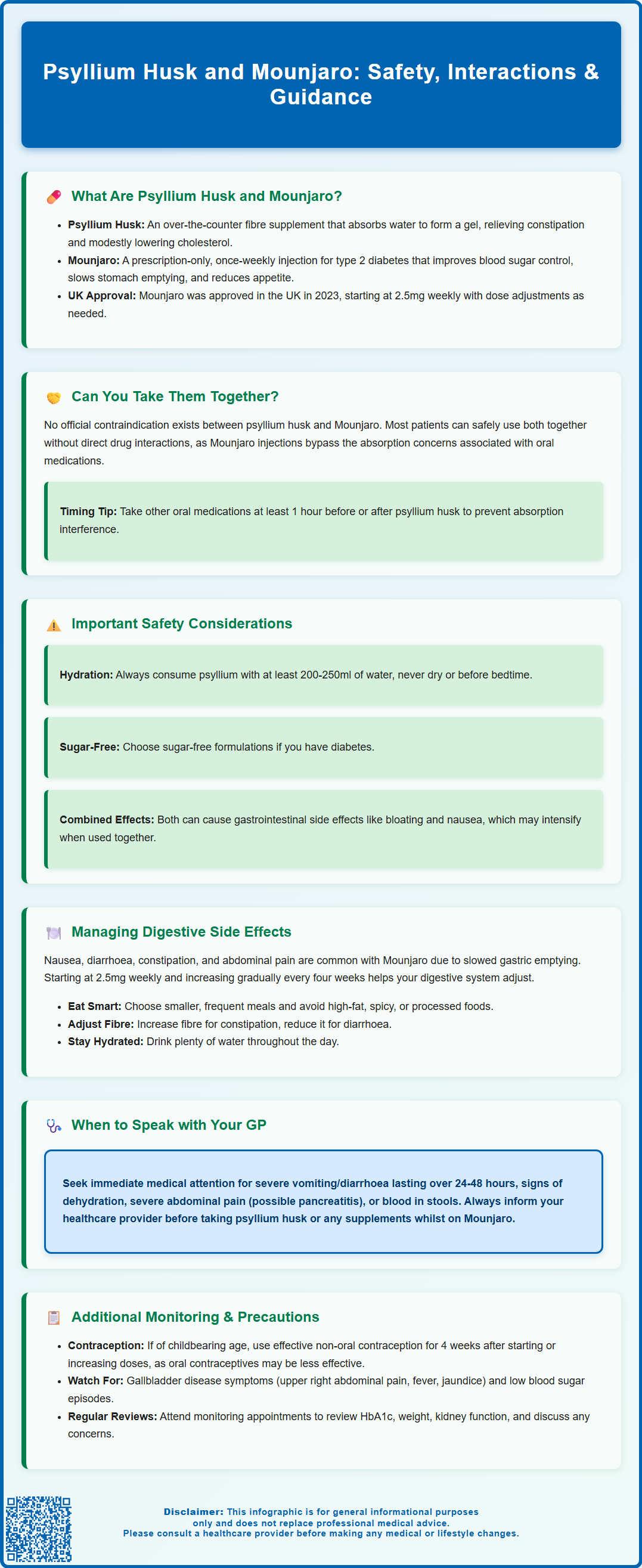Wegovy®
A weekly GLP-1 treatment proven to reduce hunger and support meaningful, long-term fat loss.
- ~16.9% average body weight loss
- Boosts metabolic & cardiovascular health
- Proven, long-established safety profile
- Weekly injection, easy to use

Many people with type 2 diabetes taking Mounjaro (tirzepatide) wonder whether they can safely use psyllium husk alongside their prescribed medication. Psyllium husk, also known as ispaghula, is a natural fibre supplement commonly used to manage constipation and support digestive health, whilst Mounjaro is a once-weekly injectable medicine that helps control blood glucose levels and often causes gastrointestinal side effects. Understanding how these two agents interact, and how to use them safely together, is important for optimising both diabetes management and digestive comfort. This article explores the evidence, practical considerations, and guidance for combining psyllium husk with Mounjaro in the UK.
Summary: There is no official contraindication to taking psyllium husk with Mounjaro, and many patients may safely use both concurrently under appropriate medical guidance.
Ispaghula (psyllium) husk is a natural dietary fibre supplement derived from the seeds of Plantago ovata, a plant native to India and Pakistan. It is classified as a bulk-forming laxative and is widely available over the counter in the UK under various brand names, including Fybogel and generic formulations. Psyllium works by absorbing water in the gastrointestinal tract, forming a gel-like substance that increases stool bulk and promotes regular bowel movements. It is commonly used to manage constipation, support digestive health, and may help with cholesterol management as part of a balanced diet (NICE recognises psyllium's modest cholesterol-lowering effects when used regularly).
Mounjaro (tirzepatide) is a prescription-only medicine licensed in the UK for the treatment of type 2 diabetes mellitus in adults. It belongs to a class of medications known as dual glucose-dependent insulinotropic polypeptide (GIP) and glucagon-like peptide-1 (GLP-1) receptor agonists. Mounjaro is administered as a once-weekly subcutaneous injection and works by enhancing insulin secretion in response to meals, suppressing glucagon release, slowing gastric emptying, and reducing appetite. These mechanisms help improve glycaemic control and often result in weight loss as a secondary effect. The Medicines and Healthcare products Regulatory Agency (MHRA) approved Mounjaro in the UK in 2023. Treatment is initiated at 2.5mg weekly (a starting dose for titration only, not for glycaemic control) and is typically prescribed when other diabetes medications have not achieved adequate blood glucose control.
Both psyllium husk and Mounjaro affect the gastrointestinal system, though through different mechanisms. Mounjaro is not recommended for patients with type 1 diabetes, diabetic ketoacidosis, or severe gastrointestinal disease including gastroparesis. Understanding how each works is essential when considering their combined use, particularly for individuals managing type 2 diabetes who may experience digestive symptoms or require additional fibre supplementation.
There is no official contraindication to taking psyllium husk alongside Mounjaro, and many patients may safely use both concurrently. No direct drug-drug interaction has been documented between tirzepatide and psyllium husk in clinical literature or regulatory guidance from the MHRA or European Medicines Agency (EMA). However, several practical considerations warrant attention when combining these agents.
Timing of administration is particularly important. Psyllium husk, as a bulk-forming fibre, can potentially affect the absorption of other medications by binding to them in the gastrointestinal tract. According to UK product information, oral medications should generally be taken at least 1 hour before or after psyllium husk to minimise potential interactions. Although Mounjaro is administered by injection and therefore bypasses first-pass metabolism and intestinal absorption, it significantly delays gastric emptying, which can reduce the exposure to oral medications. This is particularly important for oral contraceptives—additional contraceptive methods are recommended for 4 weeks after initiating Mounjaro and after each dose increase.
Gastrointestinal effects should also be considered. Mounjaro commonly causes nausea, diarrhoea, constipation, and abdominal discomfort, particularly during dose titration. Psyllium husk can cause bloating, flatulence, and abdominal cramping, especially when first introduced or if inadequate fluid is consumed. Combining both agents may theoretically compound these effects, though for some patients, psyllium may actually help regulate bowel function disrupted by Mounjaro.
Before starting psyllium husk whilst taking Mounjaro, it is advisable to consult your GP, diabetes specialist nurse, or prescribing clinician. They can provide personalised advice based on your complete medication regimen, diabetes control, and gastrointestinal symptoms. Always ensure adequate hydration when taking psyllium—at least 200–250ml of water per dose—and mix thoroughly. Never take psyllium dry, and avoid taking it immediately before bedtime to prevent oesophageal or intestinal obstruction. For people with diabetes, sugar-free formulations of psyllium products are available and may be preferable.

Gastrointestinal side effects are among the most commonly reported adverse reactions with Mounjaro, affecting a significant proportion of patients, particularly during the initial weeks of treatment and following dose increases. Nausea is the most frequent complaint, followed by diarrhoea, constipation, vomiting, dyspepsia, and abdominal pain. These symptoms typically arise due to Mounjaro's mechanism of slowing gastric emptying and its effects on gut motility.
Practical strategies can help minimise these side effects:
Gradual dose titration: Mounjaro is initiated at 2.5mg weekly (a starting dose only) and typically increased by 2.5mg every four weeks as tolerated, up to a maximum of 15mg weekly. This stepwise approach allows the gastrointestinal system to adapt. If side effects are troublesome, your prescriber may slow the titration schedule or temporarily reduce to the last tolerated dose before attempting re-escalation.
Dietary modifications: Eating smaller, more frequent meals rather than large portions can reduce nausea and bloating. Avoiding high-fat, spicy, or heavily processed foods may also help, as these can exacerbate gastrointestinal discomfort.
Adequate hydration: Drinking plenty of water throughout the day supports digestive function and can alleviate constipation, a common side effect.
Fibre intake: For constipation, gradually increasing dietary fibre through fruits, vegetables, and whole grains—or considering a supplement like psyllium husk—may be beneficial. Conversely, if diarrhoea is problematic, temporarily reducing fibre intake might help.
Timing of injection: Some patients find that administering Mounjaro at a consistent time each week, such as before bed or on a day when they can rest, helps them manage side effects more comfortably.
When symptoms persist beyond the first few weeks or significantly impact quality of life, discuss this with your healthcare team. They may adjust the dose escalation schedule, provide anti-emetic medication for nausea, or review your overall treatment plan. According to NICE guidance on type 2 diabetes management, individualised care and regular monitoring are essential to optimise both glycaemic control and tolerability of glucose-lowering therapies.
While mild gastrointestinal symptoms are expected with Mounjaro, certain situations require prompt medical attention. Contact your GP or prescribing clinician if you experience:
Severe or persistent vomiting or diarrhoea lasting more than 24–48 hours, which may lead to dehydration, electrolyte imbalance, and potentially acute kidney injury
Signs of dehydration, including dizziness, reduced urine output, dark urine, dry mouth, or feeling faint
Severe abdominal pain, particularly if constant, worsening, or accompanied by fever, as this may indicate pancreatitis—a rare but serious adverse effect of GLP-1 receptor agonists
Pain in the upper right abdomen, fever, or yellowing of the skin/eyes (jaundice), which could indicate gallbladder disease—a potential risk with GLP-1–based therapies and weight loss
Difficulty swallowing or chest pain after taking psyllium husk, which could suggest oesophageal obstruction
Blood in stools or black, tarry stools, which require urgent investigation
Unexplained weight loss beyond what is expected, or inability to maintain adequate nutrition
Worsening glycaemic control or hypoglycaemia (low blood sugar), especially if taking Mounjaro alongside insulin or sulfonylureas
Before starting psyllium husk or any new supplement whilst on Mounjaro, inform your healthcare provider. They can assess potential interactions with your complete medication list and ensure the supplement is appropriate for your individual circumstances. This is particularly important if you have a history of gastrointestinal disorders, swallowing difficulties, or intestinal obstruction.
If you are of childbearing potential, be aware that Mounjaro is not recommended during pregnancy. Use effective contraception while taking Mounjaro, and note that oral contraceptive effectiveness may be reduced due to delayed gastric emptying—consider using non-oral or additional contraceptive methods for 4 weeks after starting Mounjaro and after each dose increase. Discuss with your healthcare provider if you are planning pregnancy.
Regular monitoring is essential for anyone taking Mounjaro. Your diabetes team will typically review your HbA1c, weight, renal function, and treatment tolerability at regular intervals, in line with NICE recommendations. These appointments provide an opportunity to discuss any concerns about side effects, dietary supplements, or overall diabetes management.
For severe or worsening symptoms, contact NHS 111 or attend A&E if appropriate. Report suspected side effects to the MHRA through the Yellow Card scheme at yellowcard.mhra.gov.uk or via the Yellow Card app.
No direct drug interaction has been documented between psyllium husk and Mounjaro (tirzepatide) in clinical literature or regulatory guidance. However, psyllium can affect absorption of oral medications, so timing considerations apply, and both agents affect gastrointestinal function.
Yes, psyllium husk may help manage constipation associated with Mounjaro by increasing stool bulk and promoting regular bowel movements. Ensure adequate hydration (at least 200–250ml water per dose) and consult your healthcare provider before starting.
Contact your GP if you experience severe or persistent vomiting or diarrhoea, signs of dehydration, severe abdominal pain, difficulty swallowing, blood in stools, or worsening diabetes control. Always inform your healthcare provider before starting any new supplement.
The health-related content published on this site is based on credible scientific sources and is periodically reviewed to ensure accuracy and relevance. Although we aim to reflect the most current medical knowledge, the material is meant for general education and awareness only.
The information on this site is not a substitute for professional medical advice. For any health concerns, please speak with a qualified medical professional. By using this information, you acknowledge responsibility for any decisions made and understand we are not liable for any consequences that may result.
Lorem ipsum dolor sit amet, consectetur adipiscing elit, sed do eiusmod tempor incididunt ut labore et dolore magna aliqua. Ut enim ad minim veniam, quis nostrud exercitation ullamco laboris nisi ut aliquip ex ea commodo consequat. Duis aute irure dolor in reprehenderit in voluptate velit esse cillum dolore eu fugiat nulla pariatur.
Block quote
Ordered list
Unordered list
Bold text
Emphasis
Superscript
Subscript